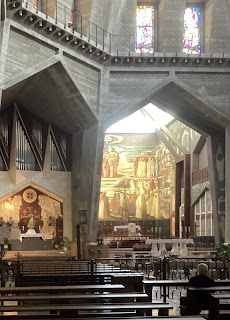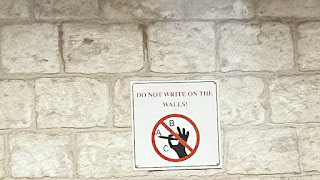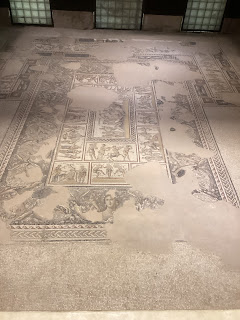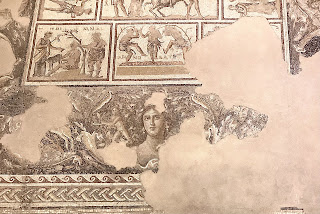Day 4
Our first destination today was the Lower Galilee town of Kfar Kana. Two thousand years ago Kfar Kana was better known as Cana, and this is where Jesus attended a wedding and performed his first miracle, turning water into wine.
Now if we were to join the genius, polymath, bow tie-wearing beagle Mr. Peabody and his adopted pet boy, Sherman and hop aboard his “Wayback machine” and travel back in time to the 4th century, we’d find a curious rich lady called Helena (Roman Emperor Constantine’s mother) walking hither and thither around Cana with her entourage pointing at random spots and asking any locals nearby, “Is this the place where Jesus went to the wedding and performed his first miracle?”
Unfortunately, she mainly spoke Greek so none of the people she asked had a clue as to what she was talking about. Disheartened, she was on the verge of giving up when a young man (who had totally misunderstood what she was asking), took her to see his cousin Ahmed (he ran a very respectable and reasonably priced wedding reception business), who took her on a tour of his reception facilities. Through a series of hand gestures and speaking slowly and loudly in his own language while adopting a thick Latin accent (so that she would surely understand him), Ahmed tried to convince her that his reception house and garden would be perfect for her son Jesus to host his wedding!
Negotiations took place, and Ahmed ended up (or so he thought) selling her his wedding reception business (house and garden included) and moved to a nice little two up two down apartment in Acre. Helena had Ahmed’s reception house bulldozed and built a nice little church there instead to commemorate Christ’s first miracle.
Fast forward about 1300 years to 1883 and the Franciscans now own this site and have just completed the construction of a new church over the remains of Helena’s one and hey presto, we have the church that we went to today to renew our wedding vows. This church is known as the “Wedding Church” and was the perfect place for Maria and I to renew our marital vows, along with five other pilgrim couples from our group.
When we got there we gathered in the courtyard and admired the modest facade (adorned with angel statues), the enclosed front porch, the balcony and the twin bell towers before making our way to the lower part of the church to see the excavated artefacts which included an ancient jar which some say could have been one of the jars used by Jesus. Our guide Mourad thinks not. He believes that this is the remains of Ahmed’s wedding reception house and that the real site is in fact 500 metres away on the other side of the main road opposite the service station.
We made our way to the Chapel of St. John where Father Wim performed the service for Maria and I, and our 10 fellow pilgrims, to recommit to each other and renew our vows. It was really beautiful and by the end of the service there wasn’t a dry eye in the house.
From there we looked around the rest of the church, (admiring a bit of a Byzantine mosaic from the 5th or 6th century in the nave), before grabbing our US$5 “marriage certificates” (thanks again fellow Pilgrim and Chief Bridesmaid Diana for purchasing ours for us as a wedding gift) and headed back to the bus.
Our next stop was the Church of the Annunciation in Nazareth. Good old Helena also visited here, spoke to the locals, and this time, we think she might’ve got it right. As a result of her efforts we have this wonderful basilica, (the biggest and most magnificent church in the Middle East), erected above the house where it is believed the Virgin Mary was born and lived before she wedded Joseph. And it was here (according to Catholic-Christian tradition) that the Annunciation took place; Mary being visited by the Archangel Gabriel who told her she was destined to give birth to Jesus.
So, all loved up and fresh from our second weddings, we pilgrims made our way to the nearby Church of St. Joseph where we celebrated another lovely and intimate Mass with Father’s Wim and Ed supported by the hardworking, ever resourceful and all round good egg, Annette. After Mass we visited the little grotto underneath which tradition says is either the site of Joseph’s workshop or the house where he, Mary and Jesus lived. Whether it is or isn’t doesn’t really matter. It belonged to someone from that period and it gives you a real sense of the environment in which Jesus grew up.
We then went for a tour of the Basilica. Words really can’t do it justice. It is just magnificent and huge. The building is about 60 meters high and houses a whole heap of colourful mosaics depicting the Holy Family. The special thing about these mosaics is that they were made by Christian communities from all over the world, and every piece of art reflects the national character of the country that sent it. Mourad’s family also contributed to the artwork with a lovely piece created by his uncle.
Above you in the centre of main section of the church is the marvelous lily dome which has been designed to symbolise the Virgin Mary’s purity. So if you are ever here, please look up.
The lower level contains the Grotto of the Annunciation, believed by many Christians to be the remains of the original birthplace and childhood home of Mary. Again, whether it is or isn’t doesn’t really matter. It is such a serene and peaceful space. Also in this space are the preserved remains of previous churches including the stone wall along the church and behind the grotto belonging to a Crusader-era church erected here in the 12th century.
After the tour we stopped for our usual Shwarma or Falafel lunch before heading north to our final destination for the day; the archaeological site at Sepphoris.
Having just checked out Mary’s home at the time of the Annunciation (she would’ve been about 14 or 15), it seemed only right that we should visit Sepphoris which is believed to be the place where she was born.
In the words of Adrian Cronauer or more correctly, Robin Williams, “It’s hot! Damn hot!” So most of our party didn’t take part in the site tour, preferring instead to lounge around at the cafe drinking coffee and eating ice cream. The rest of us budding amateur archaeology enthusiasts were in nerd heaven as we scratched our perspiration soaked heads musing about their missed opportunity and wondering what possible appeal a cool, air conditioned cafe could hold as we headed off towards the dig.
Our first stop was the synagogue dating back to the 5th century BC. I don’t mind revealing to you that I’m a bit of a fan when it comes to mosaics. I love ‘em. Father Wim loves them too and we bonded over this shared appreciation. I found out he also really, really, really, really, really, really, really, really, really, really, really, really, really, likes pottery. And I dig that (pardon the pun). We visited the Amphitheatre (I like these too) and at one point Mourad stopped, pointed at a small bush and started saying something that was fascinating to everyone except me because I didn’t have my “Whisper” doohickey turned on. When I did manage to get it working I heard him say, “Mary’s birthplace” and then everyone walked on. So I have a nice picture of a little bush that may or may not be the second birthplace of Mary.
The rest of the tour involved many more viewings of some truly wonderful mosaics, (including one which Mourad calls the “Sepphoris Mona Lisa”), a Crusader fort and a pretty cool Roman, sorry, Byzantium road.
We then realised that we had been gone a lot longer than we were supposed to have been and hurriedly made our way back to the others hoping they weren’t going to be too angry. To our surprise they were very happy and thought we’d only been gone about 20 minutes stating that this was the best part of the tour so far! Bloody Philistines. So we headed back to the hotel and the usual routine. Shower, relaxing catchup over a drink in the bar, and then dinner.
Excellent day.





















































No comments:
Post a Comment